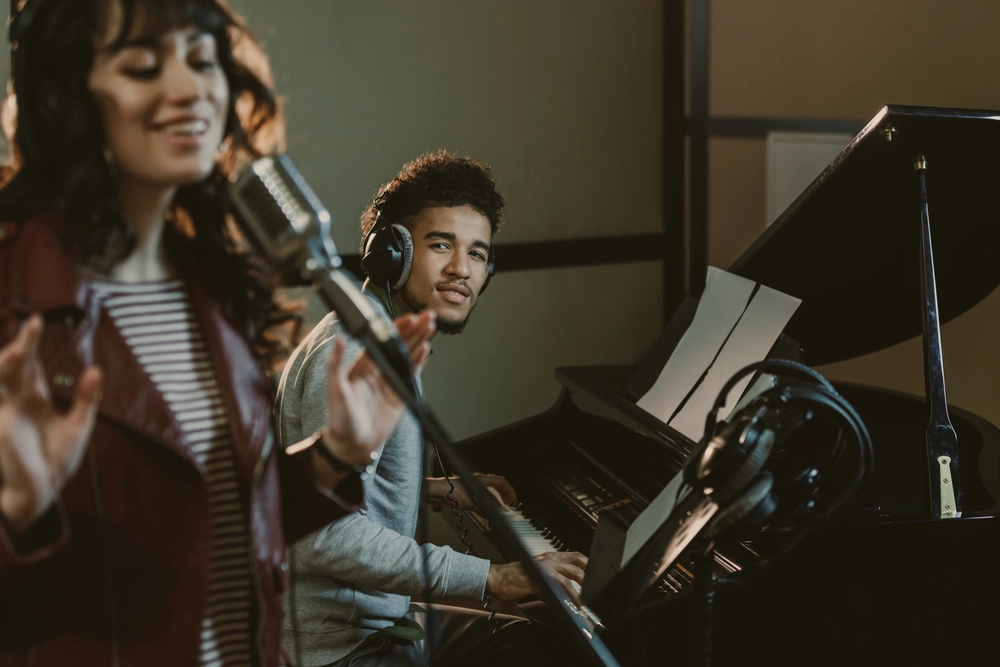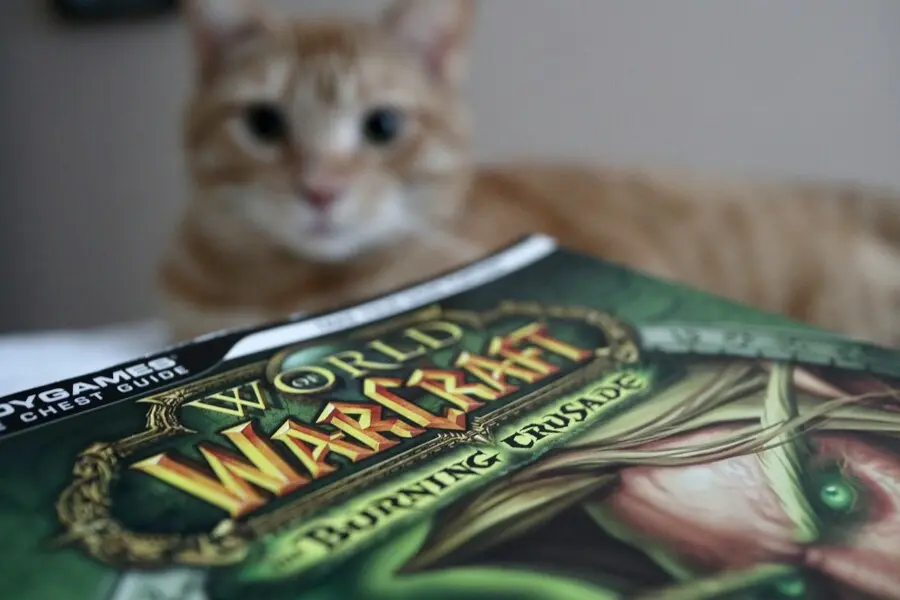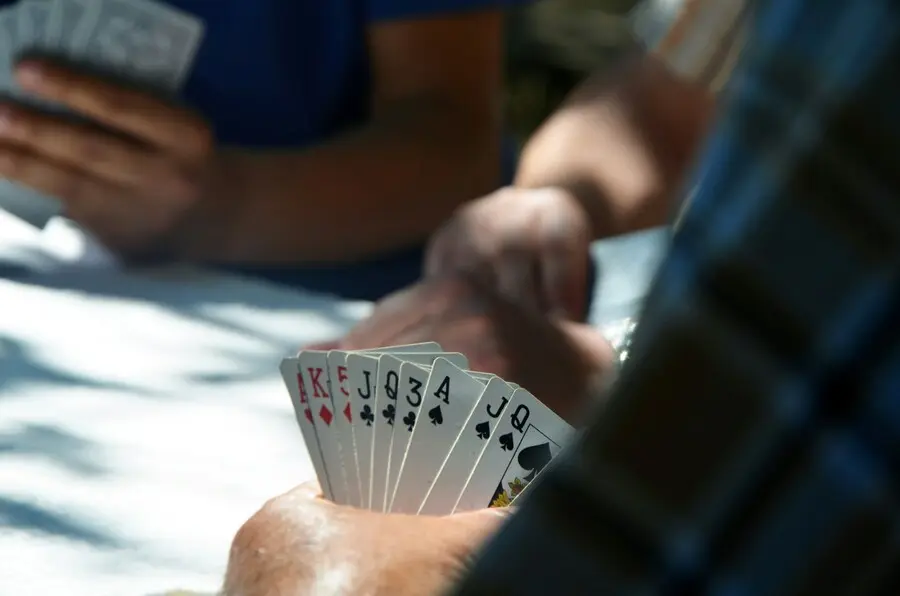Rhythm and blues (or R&B) was coined as a musical marketing term in the United States in 1949 by Jerry Wexler at Billboard magazine, and was used to designate upbeat popular music performed by African American artists that combined jazz, gospel, and blues. It replaced the term race music, which was deemed offensive, as well as the Billboard category name “Harlem Hit Parade,” in June of 1949, and was initially used to identify the rocking style of music that combined the 12 bar blues format and boogie woogie with a backbeat, later known as rock and roll. In 1948, RCA Victor was marketing black music under the name “Blues and Rhythm,” but the words were reversed by Wexler of Atlantic Records, the most aggressive and most dominant label in the R&B field in the early years. By the 1970s, rhythm and blues was being used as a blanket term to describe soul and funk as well. Today, the acronym “R&B” is almost always used instead of “rhythm and blues”, and defines the modern version of the soul and funk influenced African-American pop music that originated with the demise of disco in 1980.
Original rhythm and blues
In its first manifestation, rhythm and blues was a predecessor to rock and roll. It was strongly influenced by jazz and jump music as well as black gospel music, and influenced jazz in return (hard bop was the product of the influence of rhythm and blues, blues, and gospel music on bebop) and African tribal beats.
The first rock and roll consisted of rhythm and blues songs like “Rocket 88” and “Shake, Rattle and Roll” making an appearance on the popular music charts as well as the R&B charts. “Whole Lotta Shakin’ Goin’ On”, the first hit by Jerry Lee Lewis was an R&B cover song that made #1 on pop, R&B and country and western charts.
Musicians paid little attention to the distinction between jazz and rhythm and blues, and frequently recorded in both genres. Numerous swing bands (for example, Jay McShann’s, Tiny Bradshaw’s, and Johnny Otis’s) also recorded rhythm and blues. Count Basie had a weekly live rhythm and blues broadcast from Harlem. Even a bebop icon like arranger Tadd Dameron also arranged for Bull Moose Jackson and spent two years as Jackson’s pianist after establishing himself in bebop. Most of the studio musicians in R&B were jazz musicians. And it worked in the other direction as well. Many of the musicians on Charlie Mingus’s breakthrough jazz recordings were R&B veterans. Lionel Hampton’s big band of the early 1940s, which produced the classic recording “Flying Home” (tenor sax solo by Illinois Jacquet) was the breeding ground for many of the bebop legends of the 1950s. Eddie “Cleanhead” Vinson was a one-man fusion, a bebop saxophonist and a blues shouter.
The 1950s was the premier decade for classic rhythm and blues. Overlapping with other genres such as jazz and rock and roll, R&B also developed regional variations. A strong, distinct style straddling the border with blues came out of New Orleans and was based on a rolling piano style first made famous by Professor Longhair. In the late 1950s, Fats Domino hit the national charts with “Blueberry Hill” and “Ain’t That a Shame”. Other artists who popularized this Louisiana flavor of R&B included Clarence “Frogman” Henry, Frankie Ford, Irma Thomas, The Neville Brothers, and Dr. John.
At the start of their career, The Rolling Stones were essentially an R&B band.
Contemporary R&B
It was not until the 1980s that the term “R&B” regained ordinary usage. During that time, the soul music of James Brown and Sly & the Family Stone had adapted elements from psychedelic music and other styles through the work of performers like George Clinton. Funk also became a major part of disco, a kind of dance pop electronic music. By the early 1980s, however, funk and soul had become sultry and sexually-charged with the work of Prince and others. At that time, the modern style of contemporary R&B came to be a major part of American popular music.
R&B today defines a style of African-American music, originating after the demise of disco in 1980, that combines elements of soul music, funk music, pop music, and (after 1986) hip hop in the form known as contemporary R&B. In this context only the abbreviation “R&B” is used, not the full expression.
Sometimes referred to as “urban contemporary” (the name of the radio format that plays hip hop and R&B music) or “urban pop”, contemporary R&B is distinguished by a slick, electronic record production style, drum machine-backed rhythms, and a smooth, lush style of vocal arrangement. Uses of hip hop inspired beats are typical, although the roughness and grit inherent in hip hop are usually reduced and smoothed out.
History
Contemporary R&B singer Mary J. Blige performs on the National Mall during the “NFL Kickoff Live 2003” Concert.With the transition from soul to R&B in the early to mid 1980s, solo singer Luther Vandross and new stars like Prince (Purple Rain) and Michael Jackson (Off the Wall, Thriller) took over, and dominated the primary schools throughout the 1980s. Jackson’s Thriller, which repopularized black music with pop audiences after a post-disco backlash among United States mainstream audiences, is the best-selling album of all time worldwide.
Female R&B singers like Whitney Houston and Janet Jackson gained great popularity during the last half of the decade; and Tina Turner, then in her 50s, came back with a series of hits with crossover appeal. Also popular was New Edition, a group of teenagers who served as the prototype for later boy bands such as the New Kids on the Block, The Backstreet Boys, and others.
In 1986, Teddy Riley began producing R&B recordings that included influences from the increasingly popular genre of hip hop music. This combination of R&B style and hip-hop rhythms was termed new jack swing, and artists such as Keith Sweat, Guy, Jodeci, and BellBivDeVoe (featuring former members of New Edition). Another popular, but short-lived group, with more pronounced R&B roots was Levert, whose lead singer, Gerald Levert, was the son of O’Jays lead vocalist Eddie Levert.
In the early 1990s, R&B group Boyz II Men repopularized classic-soul inspired vocal harmony, and several similar groups (among them Shai, Soul for Real, and Dru Hill) would follow in their footsteps. Boyz II Men, and several of their competitors, benefited from lush ballads from producers such as Babyface and Jimmy Jam and Terry Lewis, who brought Michael Jackson’s sister Janet Jackson to fame during the late 1980s and early 1990s. As a solo artist, Babyface and contemporaries such as Brian McKnight eschewed prominent hip hop influences, and recorded in a smooth, soft style of R&B termed quiet storm.
In the early 1990s, alternative rock, adult contemporary, and gangsta rap ruled the charts, and R&B artists began adding even more of a rap/hip hop sound to their work. New jack swing had its synthesizer-heavy rhythm tracks replaced by grittier East Coast hip hop inspired backing tracks, resulting in a genre labeled “hip hop soul” by Sean “Puffy” Combs, producer for Mary J. Blige. Blige and other hip hop soul artists such as R. Kelly, Montell Jordan, Brandy, and Aaliyah, more than their slicker new jack swing predecessors, brought hip hop slang, style, and attitudes to R&B music. The subgenre also includes a heavy gospel influence with vocal inflections and sounds. The style became less popular by the end of the 1990s, but later experienced a resurgence. The hip hop soul sound continues to be heard in the work of artists such as Jaheim, Ashanti, Amerie, and Keyshia Cole.
During the mid-1990s, highly successful artists such as Mariah Carey, girl group TLC and the aforementioned Boyz II Men brought contemporary R&B to the mainstream. Boyz II Men and Mariah Carey recorded several Billboard Hot 100 number-one hits, including “One Sweet Day”, a collaboration between both acts which became the longest-running number-one hit
in Hot 100 history. In addition, both Boyz II Men and TLC released albums in 1994, II and CrazySexyCool, respectively, that sold over ten million copies, earning them diamond certification from the Recording Industry Association of America. Other top-selling R&B artists from this era included singer Toni Braxton, singer/songwriter/producer R. Kelly, and girl group En Vogue.
During the later part of the decade, neo soul, which added a 1970s soul music influence to the hip hop soul blend, arose, led by artists such as D’Angelo, Lauryn Hill, and Maxwell. Several artists, most notably Missy Elliott, further blurred the line between R&B and hip hop by recording in both genres simultaneously.
During the late-1990s and early 2000s, the influence of pop on R&B could be heard in the work of several pop musicians, most notably Jennifer Lopez and the later recordings of *NSYNC and the early recordings of 98 Degrees. *NSYNC’s lead singer Justin Timberlake went on to make several solo recordings that showed heavy influences from both R&B and hip hop music. Other pop stars who perform heavily R&B influenced pop music (sometimes referred to as “dirty pop”,”urban pop”, or a modern definition of “hip pop”) include Britney Spears, Gwen Stefani, and Pink.
In the United Kingdom, R&B found its way into the UK garage subgenre of 2Step, typified by R&B-style singing accompanied by breakbeat/jungle rhythms. Among the most notable 2Step artists is Craig David, who crossed over to American R&B audiences in the early 2000s.
Present day
By the 2000s, the cross-pollination between R&B and hip hop had increased to the point where, in most cases, the only prominent difference between a record being a hip hop record or an R&B record is whether its vocals are rapped or sung. Mainstream modern R&B has a sound more based on rhythm than hip hop soul had, and lacks the hardcore and soulful urban “grinding” feel on which hip-hop soul relied. That rhythmic element descends from new jack swing. R&B began to focus more on solo artists rather than groups as the 2000s progressed. As of 2005, the most prominent R&B artists include Usher, Beyoncé (formerly of Destiny’s Child), and Mariah Carey whose music often blurs the line between contemporary R&B and pop.
Soulful R&B continues to be popular, with artists such as Alicia Keys,John Legend, Toni Braxton and American Idol winner Fantasia showcasing classic influences in their work. Some R&B singers have used elements of Caribbean music in their work, especially dancehall and reggaeton.
Quiet storm, while still existent, is no longer a dominant presence on the pop charts, and is generally confined to urban adult contemporary radio. Most of the prominent quiet storm artists, including Babyface and Gerald Levert, began their careers in the 1980s and 1990s, although newer artists such as Kem also record in the quiet storm style. Its influence can still be seen in singles such as Mariah Carey’s “We Belong Together”.
In addition, several producers have developed specialized styles of song production. Timbaland, for example, became notable for his hip hop and jungle based syncopated productions in the late-1990s, during which time he produced R&B hits for Aaliyah, Ginuwine, and singer/rapper Missy Elliott. By the end of the decade, Timbaland’s influences had shifted R&B songs towards a sound that approximated his own, with slightly less of a hip hop feel. Lil’ Jon became famous for a style he termed “crunk & B”, deriving its influences from the Southern hip hop subclassification of crunk music. Jon gave his main R&B artist, Ciara, the title of “The First Lady of Crunk & B”, and Brooke Valentine and Usher have also recorded R&B songs with strong crunk influences.
Contemporary R&B subgenres
These are the major subgenres of contemporary R&B, roughly in chronological order of popularity.
Quiet storm
Quiet storm is a broad category of R&B and jazz-based music that is mellow, laid-back and often romantic. Its name comes from an innovative radio show that originated at WHUR at Howard University in the mid-1970s, named after Smokey Robinson’s hit 1975 single “Quiet Storm”. Unlike contemporary R&B, quiet storm shows little influence from hip hop, and generally plays to the urban adult contemporary crowd. The genre achieved great mainstream success during the 1980s with artists like Luther Vandross, Anita Baker, and Sade. Among other notable quiet storm musicians are Lionel Richie, Gerald Levert, Joe, and Brian McKnight.
New jack swing
A fusion of hip hop music and R&B, new jack swing was distinguished by significant use of rapped choruses or bridges and prominent use of drum machines such as the Roland TR-808. Teddy Riley and his group Guy are credited with being the inventor of the genre; other notable figures include Bobby Brown, Jimmy Jam & Terry Lewis, Jodeci, and Boyz II Men. A female alternative, new jill swing, was championed by acts such as Janet Jackson, Total, Shanice, TLC, and SWV.
Hip hop soul
Essentially new jack swing for the 1990s, hip hop soul took the style further towards a pure hip hop sound, usually accompanied by a nervy, gangsta rap-esque image. The sound was remenescent of funk with the inclusion of relatively darker baselines with elongated groove notes. Among its most notable figures were Montell Jordan, BLACKstreet, Groove Theory, and the “Queen of Hip Hop Soul”, Mary J. Blige.
Neo soul
Neo soul blends a hip hop influenced R&B sound with the classic soul of the 1970s. True neo soul is characterized by an earthy feel, accented by soul-styled harmonies, and accompanied by alternative hip hop beats. It generally has a much less mainstream sound than general R&B music. Some artists of this genre include Van Hunt, Tony! Toni! Toné!, Angie Stone, Maxwell, D’Angelo, Erykah Badu, Lauryn Hill, John Legend, Alicia Keys, and Jill Scott.
Source by Clarence Harrell












